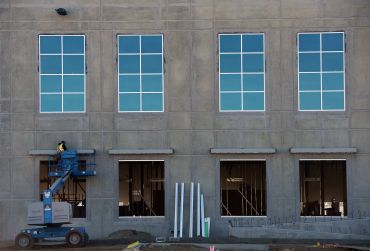The London-Based Designers Behind 1 World Trade Center’s New Logo Speak
By Daniel Edward Rosen April 11, 2012 12:40 pm
reprintsWordsearch instantly went to work, spending the next 6-to-9 months getting to grips with the complexity of the World Trade Center site.
“That was the first part of our process, was really sitting down with as many stakeholders we could, within reason, and to understand what this building meant to those various stakeholders,” said Mr. Flynn.
At that point, One World Trade Center had 600,000 square feet of underground space completed.
“About 200 feet of steel was coming out of the ground when we first got involved,” said Mr. Murray.
As One World Trade Center took shape, the duo turned to the skyline to help them hone down the color of the logo.
Wordsearch hired photographer Richard Berenholtz to take a series of shots of the New York skyline throughout the year, at different times during the day and night.
“One of the things that came out was the extraordinary range of colors that’s visible in the sky in New York throughout the year, from deep purple to dark blues to electric blues to exquisite oranges,” said Mr. Flynn.
Then there was the design of the logo itself. For the font, they used a “slightly customized” version of Hoefler & Frere-Jones’s Gotham to hearken back to the “attractive and unassuming lettering of old New York City buildings.”
The font had personality and was assertive and confident, the firm says in a marketing pamphlet.
Then there was the number “one” in the building’s name, which both men felt should be the focal point of the design.
The one symbolized the image of “being one amongst many, being first amongst many, of being the number one choice, of being New York’s number one icon,” said Mr. Flynn.
The team also focused on the new tower’s spire, which, when installed, will be perhaps among the most identifiable characteristic’s of 1 World Trade Center. That spire, the team says, will also cause onlookers to simply look up at the top of the tower, an act that carries an added symbolism to a space with a difficult history.
“We wanted to capture all the positive stuff that goes along with that, kind of hope and optimism and aspiration and forward thinking and progression,” said Mr. Flynn.
While the logo does not feature the finished building in its entirety as other proposed designs did in a 2009 NY Times article, the end result, the firm says, aims to be “sufficiently visionary and ambitious to acknowledge the broader context and wider significance of this building.”
Staff Writer Daniel Edward Rosen can be reached at drosen@observer.com or at www.twitter.com/dedwardro


